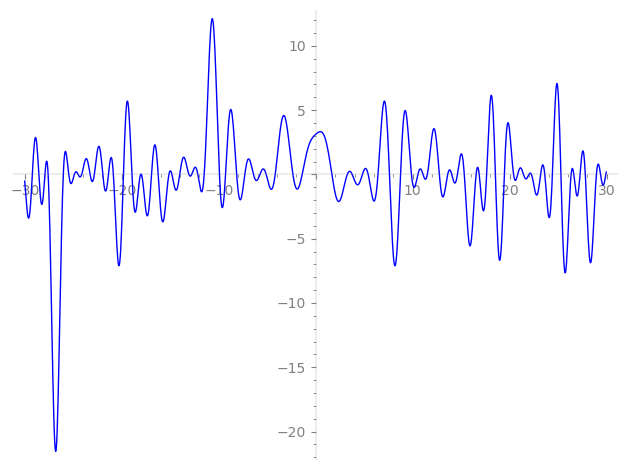| L(s) = 1 | + (1.58 + 0.915i)2-s + (−0.512 − 1.91i)3-s + (0.677 + 1.17i)4-s + (1.69 − 1.45i)5-s + (0.939 − 3.50i)6-s + (1.76 + 3.06i)7-s − 1.18i·8-s + (−0.803 + 0.463i)9-s + (4.02 − 0.752i)10-s + (1.00 + 3.74i)11-s + (1.89 − 1.89i)12-s + 6.48i·14-s + (−3.65 − 2.50i)15-s + (2.43 − 4.22i)16-s + (1.95 + 0.524i)17-s − 1.69·18-s + ⋯ |
| L(s) = 1 | + (1.12 + 0.647i)2-s + (−0.296 − 1.10i)3-s + (0.338 + 0.586i)4-s + (0.759 − 0.650i)5-s + (0.383 − 1.43i)6-s + (0.668 + 1.15i)7-s − 0.417i·8-s + (−0.267 + 0.154i)9-s + (1.27 − 0.237i)10-s + (0.302 + 1.12i)11-s + (0.548 − 0.548i)12-s + 1.73i·14-s + (−0.943 − 0.646i)15-s + (0.609 − 1.05i)16-s + (0.474 + 0.127i)17-s − 0.400·18-s + ⋯ |
Λ(s)=(=(845s/2ΓC(s)L(s)(0.940+0.340i)Λ(2−s)
Λ(s)=(=(845s/2ΓC(s+1/2)L(s)(0.940+0.340i)Λ(1−s)
| Degree: |
2 |
| Conductor: |
845
= 5⋅132
|
| Sign: |
0.940+0.340i
|
| Analytic conductor: |
6.74735 |
| Root analytic conductor: |
2.59756 |
| Motivic weight: |
1 |
| Rational: |
no |
| Arithmetic: |
yes |
| Character: |
χ845(657,⋅)
|
| Primitive: |
yes
|
| Self-dual: |
no
|
| Analytic rank: |
0
|
| Selberg data: |
(2, 845, ( :1/2), 0.940+0.340i)
|
Particular Values
| L(1) |
≈ |
3.06915−0.538620i |
| L(21) |
≈ |
3.06915−0.538620i |
| L(23) |
|
not available |
| L(1) |
|
not available |
L(s)=p∏Fp(p−s)−1 | p | Fp(T) |
|---|
| bad | 5 | 1+(−1.69+1.45i)T |
| 13 | 1 |
| good | 2 | 1+(−1.58−0.915i)T+(1+1.73i)T2 |
| 3 | 1+(0.512+1.91i)T+(−2.59+1.5i)T2 |
| 7 | 1+(−1.76−3.06i)T+(−3.5+6.06i)T2 |
| 11 | 1+(−1.00−3.74i)T+(−9.52+5.5i)T2 |
| 17 | 1+(−1.95−0.524i)T+(14.7+8.5i)T2 |
| 19 | 1+(0.518+0.139i)T+(16.4+9.5i)T2 |
| 23 | 1+(−0.294+0.0788i)T+(19.9−11.5i)T2 |
| 29 | 1+(1.71+0.988i)T+(14.5+25.1i)T2 |
| 31 | 1+(4.13+4.13i)T+31iT2 |
| 37 | 1+(−2.70+4.69i)T+(−18.5−32.0i)T2 |
| 41 | 1+(0.649−0.174i)T+(35.5−20.5i)T2 |
| 43 | 1+(2.28−8.51i)T+(−37.2−21.5i)T2 |
| 47 | 1+9.75T+47T2 |
| 53 | 1+(−3.16+3.16i)T−53iT2 |
| 59 | 1+(3.14−11.7i)T+(−51.0−29.5i)T2 |
| 61 | 1+(−1.44−2.49i)T+(−30.5+52.8i)T2 |
| 67 | 1+(−1.98−1.14i)T+(33.5+58.0i)T2 |
| 71 | 1+(−1.19+4.46i)T+(−61.4−35.5i)T2 |
| 73 | 1−14.7iT−73T2 |
| 79 | 1−1.59iT−79T2 |
| 83 | 1−7.57T+83T2 |
| 89 | 1+(4.54−1.21i)T+(77.0−44.5i)T2 |
| 97 | 1+(15.4−8.91i)T+(48.5−84.0i)T2 |
| show more | |
| show less | |
L(s)=p∏ j=1∏2(1−αj,pp−s)−1
Imaginary part of the first few zeros on the critical line
−9.924348652873880090788632466781, −9.297870130402568829817245081540, −8.152249991945685832435715572816, −7.30782033652077956986638654745, −6.41866343392385829446982987202, −5.75024934838796631770986845746, −5.10935050059026889285046138926, −4.17654878715663322820303428707, −2.35253488640686339521977504910, −1.39612149501692483280436928722,
1.66455531984593899426296289389, 3.25540819336390688373578736699, 3.75365766452158288098844516485, 4.81432045763821304972414176585, 5.40673166167496895113815774821, 6.41950503248978605406313294484, 7.60039841154012086062307504990, 8.739944427890165704839592146589, 9.864132021730974351564906183112, 10.53261787771275877583899657120

